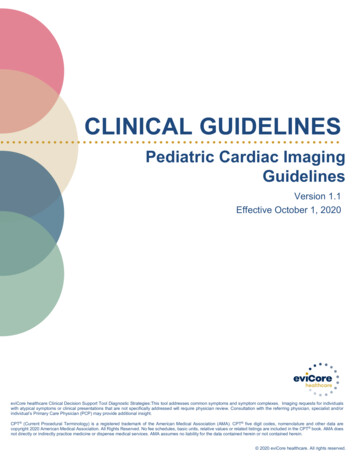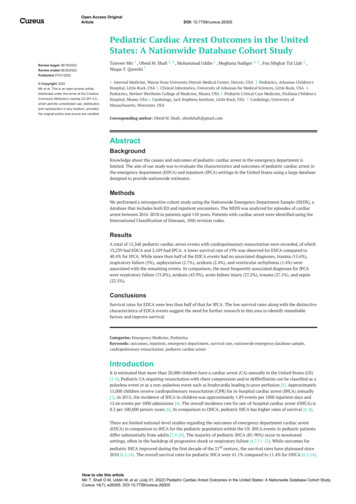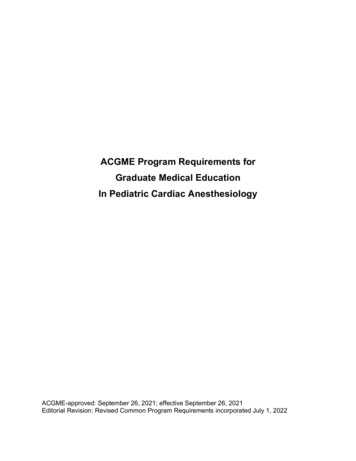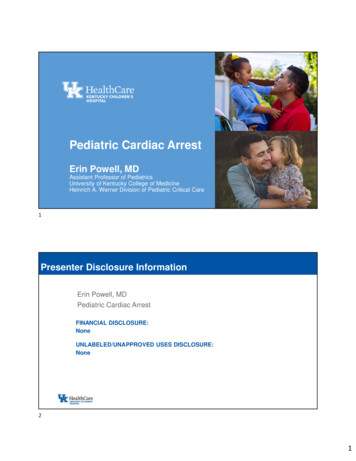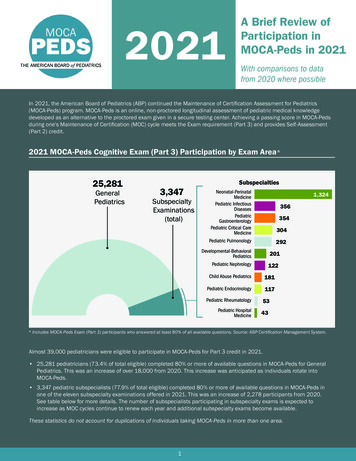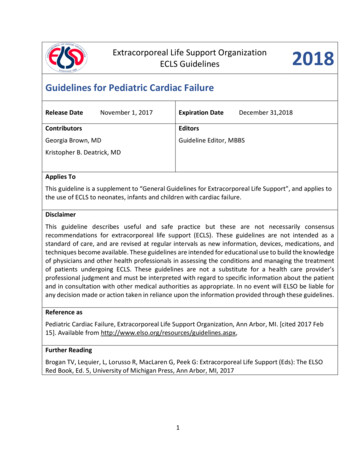
Transcription
Extracorporeal Life Support OrganizationECLS Guidelines2018Guidelines for Pediatric Cardiac FailureRelease DateNovember 1, 2017Expiration DateDecember 31,2018ContributorsEditorsGeorgia Brown, MDGuideline Editor, MBBSKristopher B. Deatrick, MDApplies ToThis guideline is a supplement to “General Guidelines for Extracorporeal Life Support”, and applies tothe use of ECLS to neonates, infants and children with cardiac failure.DisclaimerThis guideline describes useful and safe practice but these are not necessarily consensusrecommendations for extracorporeal life support (ECLS). These guidelines are not intended as astandard of care, and are revised at regular intervals as new information, devices, medications, andtechniques become available. These guidelines are intended for educational use to build the knowledgeof physicians and other health professionals in assessing the conditions and managing the treatmentof patients undergoing ECLS. These guidelines are not a substitute for a health care provider’sprofessional judgment and must be interpreted with regard to specific information about the patientand in consultation with other medical authorities as appropriate. In no event will ELSO be liable forany decision made or action taken in reliance upon the information provided through these guidelines.Reference asPediatric Cardiac Failure, Extracorporeal Life Support Organization, Ann Arbor, MI. [cited 2017 Feb15]. Available from her ReadingBrogan TV, Lequier, L, Lorusso R, MacLaren G, Peek G: Extracorporeal Life Support (Eds): The ELSORed Book, Ed. 5, University of Michigan Press, Ann Arbor, MI, 20171
Table of ContentsI. Indications and Contraindications in Children with Cardiovascular Disease(Chapter 26, 29)A. Use and strategy. . 3B. Indications . 3C. Contraindications. . 4II. Extracorporeal Circuit Characteristics. (Chapter 4,5) . 5A. Vascular access and blood flow for cardiac support. . 5B. Circuit components. . 5III. Vascular Access (Chapter 30) . 10A. Modes of access. 10B. Cannulas. . 11C. Cannulation. . 11IV. Management during ECLS (Chapter 32,33) . 13A. Circuit Related. . 13B. Medical management of Neonates and Children with CardiovascularDisease . 23V. Weaning, Trials off and Discontinuing Pediatric Cardiac ECMO (Chapter 34) .33A. Separating . 33B. When to wean. . 33C. Predictors of successful weaning. 34D. Weaning Trial Optimization . 34E. Weaning trial: . 35F. Decannulation . 35G. Surgical perspectives. . 36H. Failure to wean . 37I. Risk factors for mortality. 37J. Discontinuation of support . 37VI. Expected resultsA. Series in the literature and ELSO registry data. . 402
I.Indications and Contraindications in Children with Cardiovascular Disease(Chapter 26, 29)A.Use and StrategyCardiopulmonary Extracorporeal Life Support (ECLS) is indicated in severe, refractorycirculatory failure with reversibility and/or timely, reasonable therapeutic options.1.There are four primary strategies for ECLS use, depending on thetherapeutic objective for the patient.a)Bridge to recovery (reversible disease),b)Bridge to bridge (goal to transition to VAD or oxygenator),c)Bridge to organ transplantationd)Bridge to decision (providing time for recovery, diagnosis, ordetermination of candidacy for alternative support /transplantation).2.Use of extracorporeal life support for cardiac failure should beconsidered for patients with evidence of inadequate end organ perfusion andoxygen delivery resulting from inadequate systemic cardiac output.a)Hypotension despite maximum doses of two inotropic orvasopressor medications.b)Low cardiac output with evidence of end organ malperfusiondespite medical support as described above: persistent oliguria,diminished peripheral pulses.c)Low cardiac output with mixed venous, or superior caval centralvenous (for single ventricle patients) oxygen saturation 50% despitemaximal medical support.d)Low cardiac output with persistent lactate 4.0 and persistentupward trend despite optimization of volume status and maximalmedical management.B.IndicationsIndications for pediatric cardiac ECLS generally fall into two broad categories, thoserelated and those unrelated to cardiac surgery and catheterisation.1.Cardiac Surgery and Catheterizationa)Pre-operative stabilization – in cases where physiological stabilityis likely to be achieved over time or early operative repair is likely to havea successful outcome.b)Failure to wean from cardiopulmonary bypass.c)Elective support during high-risk catheter procedures.d)Low cardiac output in the post-operative period.2.Cardio-circulatory failure due to various etiologies3
a)Cardiogenic: Myocardial failure due to myocarditis andcardiomyopathy, intractable arrhythmia.b)Distributive: Sepsis, Anaphylaxis.c)Obstructive: Pulmonary hypertension, pulmonary embolus.3.In-hospital cardiac arrest not responsive to conventional CPR, with rapidavailability of specialist ECMO team (1).C.ContraindicationsThe list of contraindications to ECLS has shrunk over the last two decades, as a numberof conditions previously regarded as unsuitable for ECLS support have been shown to becompatible with satisfactory long-term survival. Use of ECLS is not recommended undercertain circumstances, particularly if there is strong evidence for lack of capacity torecover or be treated.1.Cardiopulmonary Extracorporeal Life Support is inappropriate if;a)The condition is irreversible and/or,b)There is no timely, reasonable therapeutic option and/or,c)High likelihood of poor neurological outcome.2.Absolute contraindications: Extracorporeal life support is notrecommended in the following circumstances;a)Extremes of prematurity or low birth weight ( 30 weekgestational age or 1 kg)b)Lethal chromosomal abnormalities (e.g., Trisomy 13 or 18)c)Uncontrollable hemorrhaged)Irreversible brain damage3.Relative contraindications:a)Intracranial hemorrhageb)Less extreme prematurity or low birth weight in neonates ( 34wk.gestational age or 2.0 kg)c)Irreversible organ failure in a patient ineligible for transplantationd)Prolonged intubation and mechanical ventilation ( 2 wk.) prior toECLSD.Special patient populationsSpecial consideration must be given to patients with the lowest rates of survival, highestrates of long-term morbidity, and greater degree of physiological complexity on ECLSsupport.1.Unrepaired Congenital Diaphragmatic Hernia2.Allogenic bone marrow transplant4
3.4.II.Bordetella Pertussis infectionSingle ventricle physiologya)Stage 1 palliative surgery (S1P): ECMO support after neonatal S1Pfor hypoplastic left heart syndrome is now the most frequent postoperative indication for ECLS (2). In S1P patients with an arterial shunt,effective use of ECMO necessitates management of the shunt to restrictpulmonary blood flow during ECMO(3). Higher ECMO flows in the rangeof 150-200ml/kg/min may improve outcomes, however, if cardiac outputremains insufficient on higher ECMO flows, then constriction of the shuntto limit pulmonary blood flow and promote systemic blood flow andtissue oxygen delivery may be necessary.b)Stage 2 and 3 palliative surgery: Infants and children after surgicalpalliation with cavopulmonary anastomoses (Glenn or Hemi-Fontan andFontan circulations) represent a complex physiological group, in whomstable support with ECMO can be difficult to establish. Establishingadequate flow in a patient with a Bidirectional Glenn or HemiFontan maybe challenging given the separation of systemic venous return.Nevertheless, ECMO can provide stable support if a reversible process ispresent.Extracorporeal Circuit Characteristics (Chapter 4, 5)A.Vascular access and blood flow for cardiac support.1.The circuit is planned to be capable of total support for the patientinvolved. Access is always venoarterial. The circuit components are selected tosupport blood flow 3 L/m2/min.a)Neonates 100 cc/kg/minb)Infants and children 80 cc/kg/minc)Adults 60 cc/kg/min2.The best measure of adequate systemic perfusion is a circuit mixedvenous saturation greater than 70%. In patients without a single mixed venousoxygen saturation, such as single ventricle and shunt-dependent patients, asuperior caval central venous oxygen saturation may be substituted. Achieving adesired flow is determined by vascular access, drainage tubing resistance, andpump properties.B.Circuit componentsThe basic circuit includes a blood pump, a membrane lung, and conduit tubing.Depending on the application, additional components may include a heat exchanger,monitors, and alarms.1.Pump5
The pump should be able to provide full blood flow for the patient, as definedabove. Any pump which meets the specifications can be used (modified rollerwith inlet pressure control; centrifugal or axial rotary pump with inlet pressurecontrol; peristaltic pump).a)Inlet (suction) pressure. With the inlet line occluded, the suctionpressure should not exceed -300 mmHg. The inlet pressure can be verylow (-300 mmHg) when the venous drainage is occluded (chattering)which causes hemolysis. Inlet pressure in excess of -300 mmHg can beavoided by inherent pump design or through a servocontrolled pressuresensor on the pump inlet side.b)Outlet pressure. With the outlet line occluded, the outletpressure should not exceed 400 mm/Hg (inherent in the pump design orby a servocontrolled system).c)Power failure. The pump should have a battery capable of at leastone-hour operation, and a system to hand crank the pump in the event ofpower failure. The pump and circuit should have a mechanism to alarmfor or prevent reverse flow (arterial to venous in the VA mode) if thepower fails.d)Hemolysis. The plasma hemoglobin should be less than 10 mg/dlunder most conditions. If the plasma hemoglobin exceeds 50 mg /dl, thecause should be investigated.2.Membrane lung (Oxygenator)a)The gas exchange material in membrane lungs may be solidsilicone rubber, a microporous hollow-fibre (e.g. polypropylene), or asolid hollow-fibre membrane (e.g. polymethylpentene). When used fortotal support, the membrane lung should provide full O2 and CO2exchange for the patient as defined in II.A.b)Membrane surface area and mixing in the blood path determinethe maximum oxygenation, described as “rated flow” or “maximal oxygendelivery”.c)Rated flow is the blood flow rate at which venous blood(saturation 75%, Hb 12 g/dl) will be fully saturated (95%) at the outlet ofthe membrane lung. Maximal O2 delivery is the amount of oxygendelivered per minute when running at rated flow.d)This is calculated as outlet minus inlet O2 content (typically 4-5cc/dL, same as the normal lung) times blood flow. For example, a specificdevice has a rated flow of 2 L/min, (max O2 100 ccO2/min). If the bloodflow required for total support of a patient is 1 L/min (O2 about 50cc/min) this membrane lung will be adequate. If the blood flow requiredfor total support is 4 L/min, this membrane lung is not adequate and thecircuit will need two of these membrane lungs in parallel, or a largermembrane lung rated at 4 L/min.6
3.Sweep gasa)The sweep gas can be 100% oxygen, carbogen (5% CO2, 95% O2)or a mixture of oxygen and compressed room delivered via an oxygen-airblender.b)The initial sweep gas flow rate is usually equal to the blood flowrate (1:1).c)Increasing the sweep flow will increase CO2 clearance but will notaffect oxygenation.d)Water vapor can condense in the membrane lung resulting inpoor CO2 clearance, and may be cleared by intermittently increasingsweep gas flow to a higher flow.4.Avoiding air embolism via the membrane lunga)Air or oxygen bubbles can pass through the membrane into theblood if the sweep gas pressure exceeds the blood pressure, or if theblood pressure is sub-atmospheric (this occurs when there is no bloodflow or blood pressure, and blood drains from the membrane lung intothe tubing by gravity, entraining air through the membrane lung). This isa specific problem with microporous hollow fiber devices but can alsooccur with silicone or polymethylpentene lungs due to very small holes inthe membrane which can allow air entrainment.b)Air embolism can be prevented by maintaining the blood sidepressure higher than the sweep gas pressure. This is accomplished byincluding a pressure pop-off valve or pressure servo regulation control inthe sweep gas supply, and by keeping the membrane lung below the levelof the patient, so that if the pump stops the risk of entraining air from theroom will be minimized. Even with silicone and PMP lungs, it is safest tomaintain the membrane lung below the level of the patient.5.Priming the circuita)The assembled circuit is primed under sterile conditions with anisotonic electrolyte solution resembling normal extracellular fluidincluding 4-5 mEq/L potassium. The prime is circulated through areservoir bag until all bubbles are removed. This can be expedited byfilling the circuit with 100% CO2 before adding the prime. Microporousmembrane lungs are quick to prime because gas in the circuit can bepurged through the micropores. The circuit can be primed at the time ofuse, or days before. It is not recommended to use a primed circuit after30 days.b)Before attaching the circuit to the patient, the water bath isturned on to warm the fluid. For patients of adequate size and7
hematocrit to avoid profound anemia, ECLS is usually instituted withcrystalloid prime. Many centers add human albumin (12.5 gm) to “coat”the surfaces before blood exposure.c)For smaller children, infants and patients who are anemic prior toinitiating ECLS, or for whom the volume of a crystalloid prime willprecipitate anemia, packed RBCs are added to bring the hematocrit to 3040.(1)When blood is added to the prime, heparin is added tomaintain anticoagulation (1 unit per cc prime) then calcium isadded to replace the calcium bound by the citrate in the bankblood. If time allows, it is helpful to verify the electrolytecomposition and ionized calcium before starting flow.(2)For emergency cannulation, the prime can be crystalloidwith hemodilution treated after initiating flow.6.Heat exchangerA heat exchanger is necessary to control the blood and the patient temperatureat a specific level. Heat exchangers require an external water bath, whichcirculates heated (or cooled) water through the heat exchange device.a)In general, the temperature of the water bath is maintained 40ºCelsius, and usually at 37º.b)Contact between the circulating water and the circulating blood isvery rare, but should be considered if small amounts of blood or proteinare present in the circulating water, or if unexplained hemolysis occurs.c)The water in the water bath is not sterile and may becomecontaminated. The water bath should be cleaned and treated with aliquid antiseptic from time to time.7.MonitorsMonitors are designed to measure circuit function and to alarm the operator ofabnormal conditions. Most circuits will include:a)Monitoring of blood flow is by direct measurement using anultrasonic detector, or calculated based on pump capacity andrevolutions per minute for a roller pump using standardized tubing.b)Pre- and post- membrane lung blood pressure measurements caninclude maximum pressure servo regulation control to avoid overpressuring.c)Pre- pump venous drainage line pressure (to avoid excessivenegative suction pressure by the pump) can be used as a servo regulationsystem to prevent excessive suction.d)Pre- and post- membrane lung oxyhemoglobin saturationmeasurements: The venous oxyhemoglobin saturation is a valuable8
parameter for managing and monitoring both circuit and patient factorsrelated to oxygen delivery and consumption. The post membrane lungsaturation monitor will determine if the membrane lung is working atrated flow, and if function is deteriorating. Blood gases are measuredfrom pre-oxygenator and post-oxygenator sites either by continuous online monitoring or batch sampling. The primary purpose of measuringblood gases (as opposed to online saturation) is to determine the inletand outlet PCO2 to evaluate membrane lung function, and blood pH todetermine metabolic status.e)Circuit access for monitors, blood sampling, and infusions. Luerconnectors and stopcocks provide access to the blood in the circuit. Thenumber of access sites should be minimized, but at least two arenecessary (pre and post membrane lung). Blood access sites should beavoided between the patient and the inlet of the pump because of therisk of entraining air. It is acceptable to use the circuit for all bloodsampling and infusions, although some centers prefer to give infusionsdirectly to IV lines in the patient.8.Alarmsa)Pre- and post- membrane lung pressure alarms. Thesemeasurements will determine the transmembrane lung pressuregradient. Clotting in the oxygenator is represented by increasingmembrane lung pressure gradient.b)Many centers use a bubble detector on the blood return line.Pressure and bubble detector alarms can be used to clamp lines and turnthe pump on or off to automate these safety factors.9.Blood tubinga)Tubing length and diameter will determine the resistance to bloodflow. Tubing is chosen to allow free venous drainage, and avoid highresistance pressure drop on the blood return side.b)The blood flow through 1 meter of tubing at 100 mmHg pressuregradient for common internal diameter in inches is:(1)3/16: 1.2 L/min;(2)¼: 2.5 L/min;(3)3/8: 5 L/min;(4)½: 10 L/minc)A “bridge” between the arterial and venous lines close to thepatient is a useful circuit component, particularly for periods off bypassduring VA access, during weaning, or during an emergency. However,when clamped the bridge is a stagnant area that can contribute tothrombosis and possibly infection. In general, if a bridge is used, it should9
be maintained closed during most of the ECLS run, with a system forpurging the bridge of stagnant blood when it is not in use.10.Elective vs. emergency circuitsThe characteristics of individual components are listed above.a)Emergency circuits should be available within minutes of the callto a patient, and should be fully primed with crystalloid and ready toattach as soon as the patient is cannulated.b)They should also include safety factors to prevent high negativepressure on the inlet side and high positive pressure on the outlet side toavoid errors during emergent cannulation and attachment.c)The emergency circuit may include a microporous membrane lung(easy to prime), and a centrifugal pump (high-pressure limited, does notrequire monitors or alarms during initial set up).d)A heat exchanger will be required for management of thesepatients.III.Vascular Access (Chapter 30)A.Modes of access.Cardiac support requires venoarterial access. The modes of access for pediatric cardiacECLS are:1.Central cannulation (transthoracic via median sternotomy)a)Can be utilized in the following scenarios;(1)Unable to wean a patient from cardiopulmonary bypass inthe operating room,(2)Rapid initiation of ECMO(3)To insert larger cannula to facilitate higher blood flowrates (e.g. sepsis)b)Cannulation is via the right atrium and aorta.c)The aortic cannula used during CPB may be too small for ECMOarterial access under prolonged conditions of normothermia, higher flowsand hematocrit. This may result in high pressures in the blood return lineand hemolysis. However, patients requiring post-cardiotomy ECLS maynot require full flow support as during the operation, for the heart andlungs should be contributing some cardiac output and gas exchange,depending on the level of impairment.2.Cervical (neck) cannulationa)VA access through the jugular and carotid is used for children 15kg because of the small size of the femoral vessels.3.Femoral cannulation10
a)The femoral or iliac vessels may be large enough to permitappropriate vascular access in children over 15 kg of weight. Both theartery and vein will be occluded by the catheter so provision must bemade for perfusion of the distal leg. Because of the small size of thedistal vessels in these patients, however, providing adequate distalperfusion is difficult and not generally recommended for patients under30 kg. Venous collateral circulation is usually adequate to avoidexcessive edema and venous congestion.B.Cannula selectiona) The term “cannula” refers to the catheter that goes directly into the vessel for ECLS,to differentiate that device from all other catheters.b) The resistance of vascular access cannulas is directly proportional to the length andinversely proportional to the radius to the fourth power. Therefore, the internaldiameter of the catheter is the most important factor controlling blood flowresistance.c) Other factors such as side holes and tapering sections also affect resistance, and theresistance increases at higher flows, so the characteristics of each cannula must beknown before cannulation.d) Blood flow at 100 mmHg gradient for commonly used cannulas is described in thepatient -specific protocols. Cannulas are chosen to provide the desired blood flow(section II A) above.C.Cannulation1.Methods:Cannulas can be placed via direct surgical exposure, such as by cannulation ofthe right atrium and aorta via sternotomy. Direct cardiac cannulation is usuallyused for patients who cannot come off CPB in the OR, using the CPB cannulas.For cervical cannulation of in neonates and small children, “cut-down” exposureof the neck vessels is usually necessary. For older children, and adults,cannulation can be accomplished via percutaneous vascular access, using theSeldinger method.2.Cannulation technique:A bolus of heparin (typically 50-100 units per kilogram) is given just beforecannula placement. In the setting of severe coagulopathy, bolus dosing ofheparin is up to the attending surgeon.a)Direct “cut-down” cannulation.Cannulation is usually done in the ICU with full sterile preparation. Deepsedation/anesthesia with muscle relaxation may be useful, but is notuniversally necessary, depending on the ability to achieve adequate localanesthesia, and the status of the patient. Local anesthesia is used for the11
skin. Dissection exposes the vessels. Direct handling of the vessels isminimized as much as possible to avoid spasm. Topical lidocaine orpapaverine is helpful to mitigate spasm. Ligatures are passed around thevessels above and below the cannulation site. Heparin is given IV (50-100units per kilogram) and the distal vessels are ligated. The proximal vesselis occluded with a vascular clamp, the vessel opened, and the cannulaplaced. If the vessels are very small, if there is difficulty with cannulation,or if spasm occurs, fine stay sutures in the proximal edge of the vessel arevery helpful. The vessel is ligated around the cannula, often over a plastic“boot” to facilitate later cannula removal. In the femoral artery a nonligation technique can be used (see semi-Seldinger technique).b)Percutaneous cannulationThe Seldinger technique is used. This is particularly suited for femoralcannulation. The bilateral groins are prepped and draped in the standardsterile fashion. The femoral artery and vein are visualized usingultrasound. If the patient is hemodynamically stable (not rapidlydecompensating), it is easiest to first access the distal superficial femoralartery and place the distal perfusion catheter. The common femoralartery is then accessed, and dilated to allow passage of the appropriatelyselected arterial cannula. Once the arterial cannula are placed, thecontralateral femoral vein is accessed under ultrasound guidance, andthe venous (drainage) cannula is placed and advanced to the appropriatelevel (so that the tip of the cannula is approximately at the IVC / RAjunction). The sterile end of the lines are connected on the field, takingcare to eliminate air bubbles. In the event of the acutely decompensatingpatient, such as in eCPR, the arterial cannula is placed first, to stabilizethe patient, and the distal perfusion catheter is placed later.3.Management of the distal vessels:a)If cervical cutdown access is used, the vein and artery are ligateddistally, relying on collateral circulation to and from the head. Somecenters routinely place cephalad venous cannula but this is aninstitutional preference and is not mandatory.b)If the access is via the femoral vessels, the venous collateraldrainage is adequate but the femoral artery is significantly occluded.Distal pulses must be ascertained and documented prior to and aftercannulation. A distal reinfusion catheter is strongly recommended toavoid limb ischemia. Using the Seldinger technique, a reinforced 6Fcannula may be placed in the superficial femoral artery usingultrasonography guidance. If the cannula is placed by cut down, a distalperfusion catheter may be placed at the same time. In the stable patient,this may be more easily placed prior to placement of the arterial cannula.In the setting of the extremely unstable patient, such as during ECPR, the12
cannula should always be placed first. An alternative to this is the use ofthe posterior tibial artery for retrograde perfusion. In any circumstance,the cannulating surgeon MUST determine and document adequate distalperfusion prior to the completion of the cannulation procedure.4.IV.Adding or changing cannulas:a)If venous drainage is inadequate the first step is to assessintravascular volume status (consider bleeding, or other sources of bloodloss) and venous cannula position.b)If volume is adequate and the cannula is properly positioned,drainage may be limited by the resistance of the drainage cannula. In thisscenario, it is best to first add another venous drainage cannula through adifferent vein.c)It may be possible to change the cannula to a larger size, butremoving and replacing cannulas can be difficult, and the patient may nottolerate even the short amount of time off of support. If a vascular accesscannula is punctured, kinked, damaged, or clotted, the cannula must bechanged.d)If the cannula was placed by direct cut down, the incision isopened, the vessel exposed, and the cannula replaced, usually with theaid of stay sutures on the vessel. If the cannula was placed bypercutaneous access, it may be possible to exchange the catheter over aguidewire in the Seldinger method.Management during ECLS (Chapter 32, 33)A.Circuit Related. Circuit components are selected based on patient size, and theamount of flow required for support.1.Blood flowAfter cannulation, blood flow is gradually increased to mix the circulating bloodwith the prime; then, blood flow is increased until maximum flow is achieved.This is done to determine the maximum flow possible based on the patient andthe cannula resistance. After determining maximum possible flow, (the bloodflow is decreased to the lowest level that will provide adequate support. Ideallyfor VA access, the pump flow is decreased until the arterial pulse pressure is atleast 10 mmHg (to assure continuous flow through the heart and lungs duringECLS), but this is often not possible when the heart function is very poor. Thephysiologic goals (mean arterial pressure, arterial and venous saturation) are setand blood flow is regulated to meet the goals.2.Oxygenationa)The rated flow is the blood flow rate at which venous blood with a13
saturation of 75% and hemoglobin of 12g/dl with exit the gas exchangedevice with a saturation of 95%.b)The rated flow is a standard to compare the maximumoxygenation capacity of gas exchange devices, and is determined bysurface area and blood path mixing.c)As long as the blood flow is below recommended rated flow forthat gas exchange device (and the inlet saturation is 70% or higher) theoxyhemoglobin saturation at the outlet should be greater than 95%.Usually the outlet saturation will be 100% and the PO2 will be over300mmHg.d)If the sweep Fi02 is 100%, at or below the device rated flow, andthe outlet saturation is less than 95%, the gas exchange device is notworking at full efficiency (due to irregular flow, clotting). It may benecessary to replace it.e)Oxygen delivery from the circuit should be adequate for fullsupport (systemic saturation greater than 95% at low ventilator settingsand FiO2).f)Venous saturation should be 20-30% saturation less than arterialsaturation. This indicates that syste
d) Low cardiac output with persistent lactate 4.0 and persistent upward trend despite optimization of volume status and maximal medical management. B. Indications Indications for pediatric cardiac ECLS generally fall into two broad categories, those related and those unrelated to cardiac surgery and catheterisation. 1.


